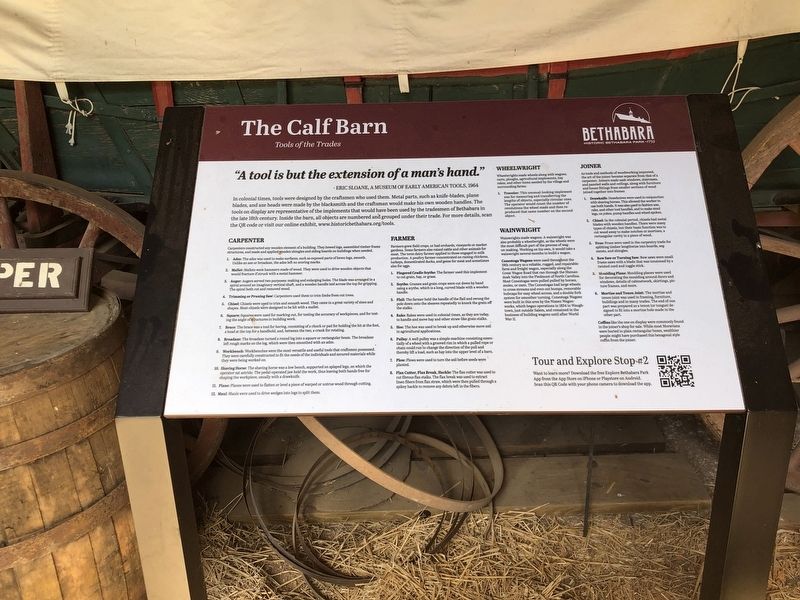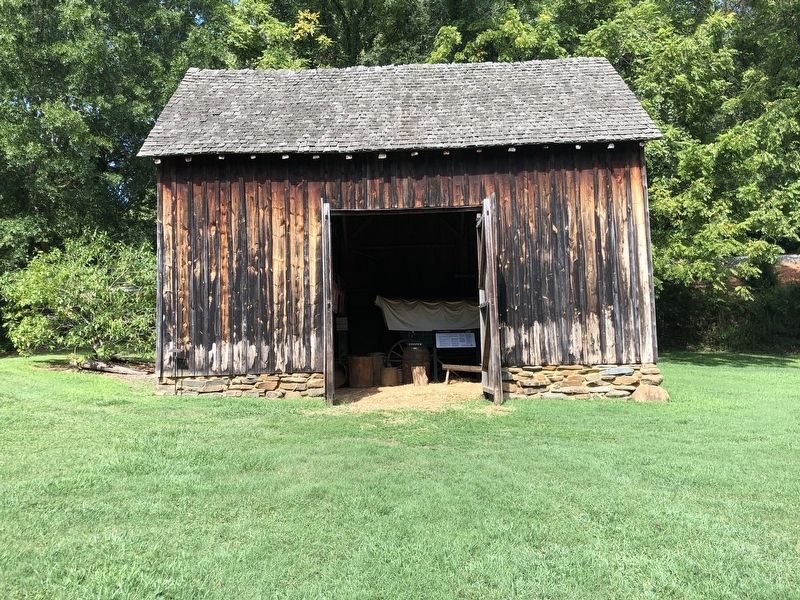Oldtown in Winston-Salem in Forsyth County, North Carolina — The American South (South Atlantic)
The Calf Barn
Tools of the Trades
In colonial times, tools were designed by the craftsmen who used them. Metal parts, such as knife-blades, plane blades, and axe heads were made by the blacksmith and the craftsman would make his own wooden handles. The tools on display are representative of the implements that would have been used by the tradesmen of Bethabara in the late 18th century. Inside the barn, all objects are numbered and grouped under their trade. For more details, scan the QR code or visit our online exhibit, www.historicbethabara.og/tools.
Carpenter
Carpenters constructed any wooden element of a building. They hewed logs, assembled timber frame structures, and made and applied wooden shingles and siding boards on buildings when needed.
1. Adze: The adze was used to make surfaces, such as exposed parts of hewn logs, smooth. Unlike an axe or broadaxe, the adze left no scoring marks.
2. Mallet: Mallets were hammers made of wood. They were used to drive wooden objects that would fracture if struck with a metal hammer.
3. Auger: Augers served two purposes: making and enlarging holes. The blade was arranged in a spiral around an imaginary vertical shaft, and a wooden handle laid across the top for gripping. The spiral both cut and removed wood.
4. Trimming or Pruning Saw: Carpenters used them to trim limbs from cut trees.
5. Chisel: Chisels were used to smooth and trim wood. They came in a great variety of sizes and shapes. Most chisels were designed to be hit with a mallet.
6. Square: Squares were used for marking out, for testing the accuracy of workpieces, and for testing the angle of structures in building work.
7. Brace: The brace was a tool for boring, consisting of a chuck or pad for holding the bit at the foot, a head at the top for a handhold, and, between the two, a crank for rotating.
8. Broadaxe: The broadaxe turned a round log into a square or rectangular beam. The broadaxe left rough marks on the log, which were then smoothed with an adze.
9. Workbench: Workbenches were the most versatile and useful tools that craftsmen possessed. They were carefully constructed to fit the needs of the individuals and secured materials while they were being worked on.
10. Shaving Horse: The shaving horse was a low bench, supported on splayed legs, on which the operator sat astride. The pedal-operated jaw held the work, thus leaving both hands free for shaping the workpiece, usually with a drawknife.
11. Plane: Planes were used to flatten or level a piece of warped or untrue wood through cuttng.
12. Maul: Mauls were used to drive wedges into logs to split them.
Farmer
Farmers grew field crops, or had orchards, vineyards, or market gardens. Some farmers also raised cattle and other animals for meat. The term dairy farmer applied to those engaged in milk production. A poultry farmer concentrated on raising chickens, turkeys, domesticated ducks, and geese for meat and sometimes also for eggs.
1. Fingered Cradle Scythe: The farmer used this implement to cut grain, hay or grass.
2. Scythe: Grasses and grain crops were cut down by hand using a scythe, which is a long, curved blade with a wooden handle.
3. Flail: The farmer held the handle of the flail and swung the pole down onto the sheaves repeatedly to knock the grain off the stalks.
5. Hoe: The hoe was used to break up and otherwise move soil in agricultural applications.
6. Pulley: A well pulley was a simple machine consisting essentially of a wheel with a grooved rim in which a pulled rope or chain could run to change the direction of the pull and thereby lift a load, such as hay into the upper level of a barn.
7. Plow: Plows were used to turn the soil before seeds were planted.
8. Flax Cutter, Flax Break, Hackle: The flax cutter was used to cut fibrous flax stalks. The flax break was used to extract linen fibers from flax straw, which were then pulled through a spikey hackle to remove any debris left in the fibers.
Wheelwright
Wheelwrights made wheels along with wagons, carts, ploughs, agricultural implements, hay rakes, and other items needed by the village and surrounding farms.
1. Traveler: This unusual-looking implement was for measuring and transferring the lengths of objects, especially circular ones. The operator would count the number of revolutions the wheel made and then reproduced that same number on the second object.
Wainwright
Wainwrights made wagons. A wainwright was also probably a wheelwright, as the wheels were the most difficult part of the process of wagon-making. Working on his own, it would take a wainwright several months to build a wagon.
Conestoga Wagons were used throughout the 19th century as a reliable, rugged, and repairable farm and freight wagon, especially along the Great Wagon Road that ran through the Shenandoah Valley into the Piedmont of North Carolina. Most Conestogas were pulled by horses, mules, or oxen. The Conestoga had large wheels to cross streams and even out bumps, removable hubcaps for easy wheel access, and a double fork system for smoother turning. Conestoga wagons were built in this area by the Nissen Wagonworks, which began operations in 1834 in Waughtown, just outside Salem, and remained in the business of building wagons until after World War II.
Joiner
As tools and methods of woodworking improved, the art of the joiner became separate from that of a carpenter. Joiners made sash windows, staircases, and paneled walls and ceilings, along with furniture and house fittings from smaller sections of wood joined together into frames.
1. Drawknife: Drawknives were used in conjunction with shaving horses. This allowed the worker to use both hands. It was also used to fashion axe, rake, and other tool handles, and to make stool legs, ox yokes, pump handles and wheel spokes.
2. Chisel: In the colonial period, chisels had metal blades with wooden handles. There were many types of chisels, but their basic function was to cut wood away to make notches or mortises, a rectangular cavity in a piece of wood.
3. Froe: Froes were used in the carpentry trade for splitting lumber lengthwise into boards, segments, and shingles.
4. Bow Saw or Turning Saw: Bow saws were small frame saws with a blade that was tensioned by a twisted cord and toggle stick.
5.Moulding Plane: Moulding planes were used for decorating the moulding around doors and windows, details of cabinetwork, skirtings, picture frames, and more.
6. Mortise and Tenon Joint: The mortise and tenon joint was used in framing, furniture, buildings and in many trades. The end of one part was prepared as a tenon (or tongue) designed to fit into a mortise hole made in the other part.
Coffins like the one on display were commonly found in the joiner's shop for sale. While most Moravians were buried in plain rectangular boxes, wealthier people might have purchased this hexagonal style coffin from the joiner.
Erected by Historic Bethabara Park. (Marker Number 2.)
Topics. This historical marker is listed in these topic lists: Man-Made Features • Roads & Vehicles. A significant historical year for this entry is 1834.
Location. 36° 9.343′ N, 80° 17.813′ W. Marker is in Winston-Salem, North Carolina, in Forsyth County. It is in Oldtown. Marker can be reached from Bethabara Road, 0.2 miles north of Indiana Avenue, on the right when traveling north. The Calf Barn is southwest of the Historic Bethabara Park Visitor Center. Touch for map. Marker is at or near this postal address: 2155 Bethabara Rd, Winston Salem NC 27106, United States of America. Touch for directions.
Other nearby markers. At least 8 other markers are within walking distance of this marker. Calf Barn 1765 (a few steps from this marker); The Log House • 1834 (within shouting distance of this marker); The Palisade (within shouting distance of this marker); The Foundations (within shouting distance of this marker); Gemeinhaus • 1788 (within shouting distance of this marker); Palisade Fort (within shouting distance of this marker); Congregation Store 1759 & 1764 (within shouting distance of this marker); Pottery Shop 1755 (about 300 feet away, measured in a direct line). Touch for a list and map of all markers in Winston-Salem.
Credits. This page was last revised on October 16, 2023. It was originally submitted on October 5, 2023, by Duane and Tracy Marsteller of Murfreesboro, Tennessee. This page has been viewed 46 times since then and 6 times this year. Photos: 1, 2. submitted on October 5, 2023, by Duane and Tracy Marsteller of Murfreesboro, Tennessee.

